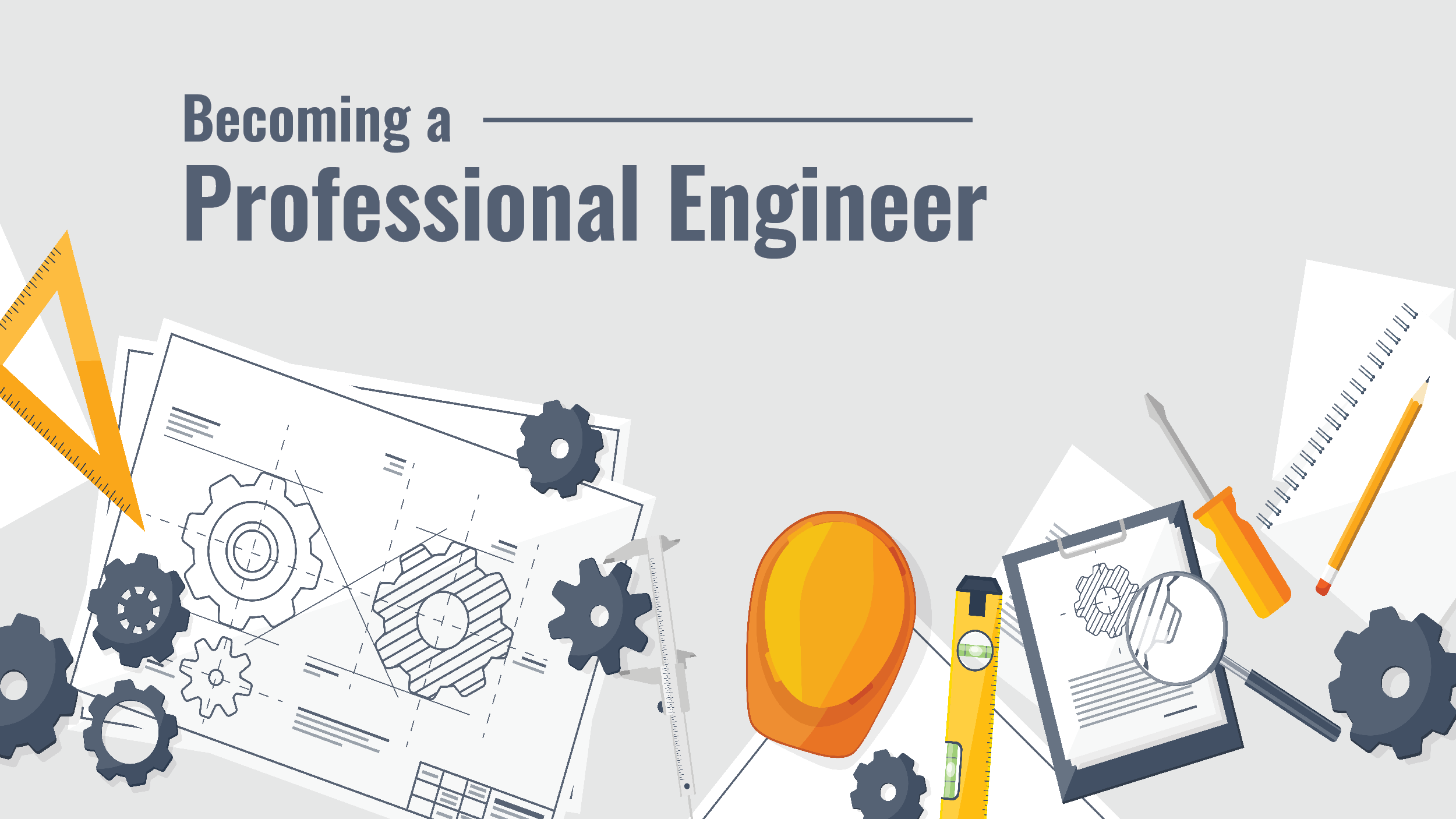Becoming a Professional Civil Engineer
In the world of engineering, the reliability and trustworthiness of an engineer’s designs are key. After all, engineering touches almost every aspect of our daily lives, from the buildings we live in, to the roads we drive on and everything in between. Without the heavy regulation that accompanies the industry, we may not be able to depend on this infrastructure—and that can be very dangerous to the people who rely on the work of engineers to go about their day-to-day lives. As a result, structural and civil engineering requires a lot of heavy regulation, responsibility, training, and good old-fashioned hard work. However, with the proper education, experience, and dedication to the craft, becoming a Professional Engineer is possible for anyone to achieve.

What is a Professional Engineer (PE)?
In short, a Professional Engineer is an engineer who has gone through all the necessary steps to earn their licensure. This means that they have not only completed a four-year college degree but also worked and studied under a Professional Engineer for several years (depending on the state), passed several intensive exams to measure their competency, and earned a license from their state’s licensure board.
Even after getting their license, an engineer must maintain their PE title by continuing their education and learning new skills. The world around us is moving at an exponential rate. New materials, methods, and safety measures are being discovered and discussed every year. Continued education is measured by Professional Development Hours (PDH), which numerous sources, such as online classes, webinars, and seminars, can fulfill. Though the amount of PDHs needed varies by state, the result is the same: each respective state Board of Professional Engineers enforces PDH requirements to ensure that licensed PEs are up to date on modern tools, techniques, laws, and ethics.
Obviously, this is no small feat. It’s not hyperbole to say that engineers’ work affects the lives and safety of everyone around them. This is why they must go through so much rigorous, continuous training to ensure their reliability. A Professional Engineer designation tells clients that you have the credentials worth their time, money, and trust—and it tells employers that you’ve taken on the continued responsibility to provide critical services.
What’s the difference between an Engineer and a PE?
A Professional Engineer fulfills key tasks that can only be performed by someone of their status. This includes preparing, signing, and submitting plans and drawings for approval. Licensure is a legal requirement for these tasks to take place—a PE is the one who is primarily responsible for the design and construction of their work, and thus the safety and wellbeing of those who will use their designs.
It’s also professionally desirable. Most higher-level positions, both inside the government and in private firms, require a PE to fill their higher-level roles. To continue to progress through the industry, earning your PE license is a must.
I’m still in High School. What should I focus on?
If you’re a high school student, choosing your career path can be a bit overwhelming. If you know you’re going to want to be an engineer, though, then you can begin preparing before you graduate!
One way you can accelerate the process is by looking into AP courses, such as AP Calculus, AP Statistics, AP Chemistry, and AP Physics. By doing so, you’ll put yourself ahead of some of your peers and cut down on the amount of time you will be spending in a classroom once you’re in college. Some schools offer specialized STEM courses as well—this varies from district to district, so keep an eye out!
Another thing that can help put you ahead is by getting ‘hands on’ with clubs, projects, and volunteer work. You don’t always have to pick something technical—even joining a band can help develop parallel skills that will help you in the future. Being part of extracurricular activities is integral to developing a well-rounded set of skills and experiences.
The most important thing you can do at this stage is to focus on yourself and your grades. After all, engineering is about more than building—you will have to write proposals, work well with a team, understand government policy, and more. This means you shouldn’t neglect your non-STEM courses just because they’re not ‘traditional’ classes for your intended field. It’s important to be holistic in your approach to education! By making yourself an attractive candidate for colleges, you’ll have more freedom to pursue the engineering program of your choice.

How to Become a Professional Engineer
So, we’ve laid out the basics of a Professional Engineer. But how do you become one?
There are five basic steps to earning your professional engineering license:
- Obtain an ABET-accredited engineering program education.
- Pass the Fundamentals of Engineering (FE) exam.
- Become an Engineer-in-Training (EIT) or Engineering Intern (EI) and gain progressive engineering experience, of which some must be done under the supervision of a professional engineer (the length of time is determined by your state).
- Pass the Principles and Practice of Engineering (PE) exam.
- Continue to maintain your license through PDH credits every one or two years, depending on the state.
Step One: Education
Anyone seeking to become a professional engineer must complete a four-year Bachelor’s program. Most colleges offer a 4-year program for civil engineering, and these programs offer different areas of expertise depending on the college. The Accreditation Board of Engineering and Technology (ABET) assesses these programs to verify that they teach the material needed to succeed in the field. You’ll want to ensure the program you are entering is ABET credited to ensure that you will gain the proper skills and knowledge needed to enter your field successfully. If you don’t attend an ABET-credited institution (because you studied abroad or for other reasons), that’s okay! You can still pursue a PE designation—it might just take a little longer.
As you progress through your education, you may decide on a specialization track, such as structural engineering. You will focus on that specialization for your junior and senior years of undergrad. Advanced specializations also take a student beyond the four years normally required of a civil engineer—which means that some specializations leave students with six years of educational experience.
Though there are Master’s programs, most are not necessary to enter the field. Instead, individuals who seek to earn their Professional Engineering license will further their education through Professional Development Hours, as previously mentioned. While some firms may still seek out individuals with graduate degrees, this is not a necessity. Look into the job prospects within your area (or the area you would like to work in) to gauge whether or not this step is right for you.
Step Two: Pass the Fundamentals of Engineering exam
Next, you must pass your Fundamentals of Engineering (FE) exam. This exam covers a wide range of information taught in accredited undergraduate programs nationwide. If your school’s program is ABET-accredited, then you should be qualified to take this exam in your final semester. Once you pass this exam, you can go on to the next stage of your journey to professional licensure.
Step Three: Earn Progressive Engineering Experience
This one is not as uniform as the previous two steps. Once you have completed your education and passed the FE Exam, you qualify for your engineer-in-training (EIT) or Engineering Intern (EI) certification. This certification is indefinite and persists throughout the next phase of your training: progressive engineering experience.
Though it varies from state to state, every EIT or EI must complete time in the field actively working on projects to prove they are viable for a PE designation. This usually looks like several years of full-time work in the field of engineering. A licensed Professional Engineer must supervise at least half of your time to ensure that any errors you may make are addressed and corrected while you pursue this experience.
There are some exceptions to this—for instance, if you pursued a master’s degree, it may substitute as qualified time in the field. States may also have different requirements; for instance, North Carolina does not have a time requirement for taking the PE exam so long as you have graduated and passed your FE exam. However, it is important to note that part-time work does not qualify for this four-year requirement—and though some firms offer intern positions, they may not qualify for eligibility, either. Be very thorough with your research before accepting a position to ensure it will go towards your experience goals.
Step Four: Pass your exams!
The PE Exam, or the Principles and Practices of Engineering Exam, puts your acquired knowledge and experience to the test. This assessment is one that you have to sign up for. Some states have this occur during specific months, such as October and April, while others, like North Carolina, let you take the test at any point in the year. Though overcoming this eight-hour-long test can be grueling, you will qualify for your Professional Engineering license if you pass it!
If you’re in California, you have two additional tests to take before qualifying—the seismic and surveying exams. These two-and-a-half hour-long tests are offered on a rolling basis and are required by the State of California for your PE license.
If you’re going to become a licensed Structural Engineer, you have to pass another exam: the SE. This exam’s timing can also vary by state, so ensure you’re up-to-date on when the exam is offered in your location. Given over the course of two days, this sixteen-hour long exam has two sections that can be passed independently, so if you pass one of them, you don’t have to retake it to pass the other.
Once you pass your examination, you must submit your application for licensure including your progressive engineering experience gained, your professional references, and verification of passing both the FE and PE exams. The respective state Board will review the application and if all requirements have been met, congratulations, you’re a Professional Engineer!
Step Five: Maintain your License
Though you may have your license, your journey doesn’t end here. As previously stated, to maintain your status as a Professional Engineer, you must maintain your education by pursuing Professional Development Hours via online courses, webinars, and other officially recognized sources of continued professional development. Each state has its own hour requirements. Some states do not require you to submit evidence of your qualifying PDH success, but this doesn’t mean you can lie: if you’re subjected to an audit, they will go through several years of PDH backlog, and in this case, you will have to present evidence that you successfully completed each qualifying activity

What’s Next?
Once you have your license—Congratulations! Your new PE license drastically increases your career prospects. You are now qualified to sign, seal, and submit engineering plans. You meet the legal requirements to consult on projects, and you can serve as a mentor to other up-and-coming engineers-in-training. Earning your PE means that you have the authority and experience to work in higher-paid positions throughout the industry. Overall, it is a great tool to seek out further opportunities and success in the career field—and this highly-sought after designation can often be the determining factor in landing new positions, as your proven dedication to the industry brings a lot of value to firms.
Are you looking to get started in the industry? Check out our open job listings on our career page!
Conclusion
Becoming a PE is no easy task. It requires a significant investment of time, money, and work to accomplish the task of earning this prestigious designation and license. This worthwhile investment may seem challenging, but the payoff is not to be overlooked! By dedicating yourself to the field, you set yourself apart from other engineers—and become an attractive prospective candidate in doing so.

